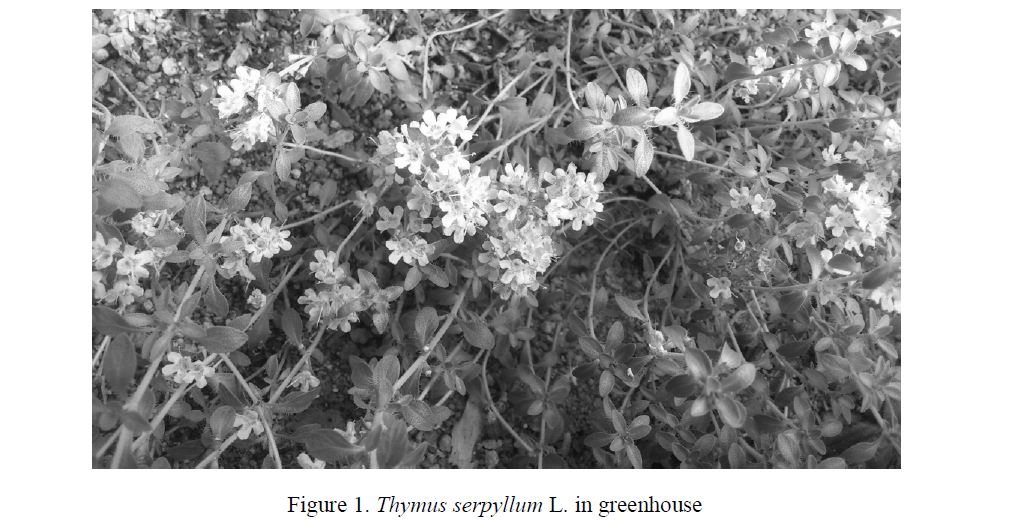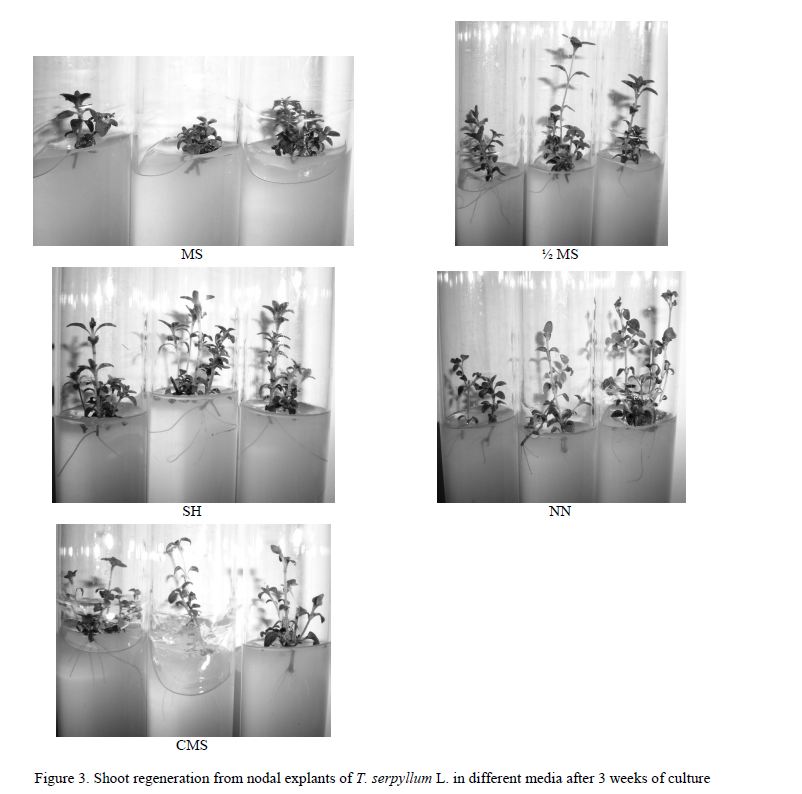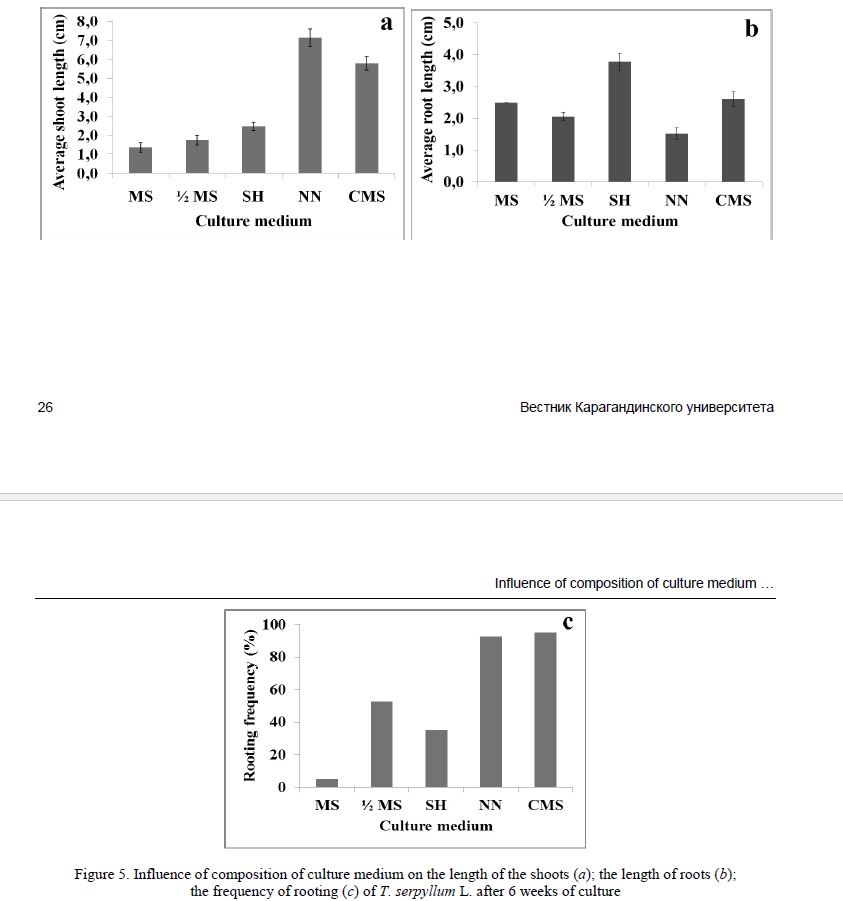Thymus serpyllum L. is a species of a flowering plant in the mint family Lamiaceae. Thymus serpyllum L. is widely used in medicine and pharmaceutics, in cookery, in perfumery, cosmetology, as a honey plant, and as an ornamental plant. As a result of the man's impact (developing of virgin lands, unregulated recreation, degradation as a result of grazing of cattle and other types of breaking) the area of the creeping thyme in Northern Kazakhstan reduces noticeably. So, an important task is the development of the ways of conservation of this valuable steppe plant. The using of methods of biotechnology is one of the optimum decisions of the given question. Initial explants — nodal segments of Thymus serpyllum L. — were cultivated on culture media Murashige and Skoog (MS), 1AMS, modified by Collet of Murashige and Skoog (CMS), modified Nitsch and Nitsch (NN), Schenk and Hildebrandt (SH). Modified NN medium proved to be the most favorable for cultivation of explants of T. serpyllum L.After six weeks of cultivation of the creeping thyme on a given culture medium, an average length of shoots amounted to 7.13±0.9 cm, the frequency of rooting — 92.5 %, an average length of roots- 1.52±0.4 cm. The multiplication factor was equal to 1:9.
In composition of flora of herbaceous plants on the territory of state institutions of Akmolinskaya and North-Kazakhstan oblasts there are sorts, having economic importance. The most valuable of them is the group of food and medicinal plants. One of such plants is the creeping thyme (Thymus serpyllum L.).

Thymus serpyllum L. is a species of a flowering plant in the mint family Lamiaceae (Fig. 1). The creeping thyme is spread throughout the whole territory of the Commonwealth of Independent States including Kazakhstan, the Russian Federation, and the Ukraine, especially on Polesye, in Siberia and in Caucasia. Thymus serpyllum L. grows in a temperate zone of Eurasia spreading in the north up to Murmanskaya oblast of the Russian Federation (Kandalaksha), as well as up to Northern Caucasia and the Crimea. In the Ukraine and in Kazakhstan Thymus serpyllum L. is spread almost everywhere with the exception of Central Kazakhstan. Thymus serpyllum L. is also found at the foothills of Tibet, in the north of India and in North America. In Armenia Thymus serpyllum L. has been grown as a garden culture for a long time [1].
Thymus serpyllum L. is widely used in medicine and pharmaceutics (possesses bactericidal, antispas-modic, sedative, anodyne, healing, antioxidant, antivermicular effects and others), in cookery (as spice for meat course; at production of drinks), in perfumery, cosmetology, as a honey plant, and also it is used as an ornamental plant (decorates gardens, doorways of the houses, enclosed courts of the houses and balconies) [1, 2].
The strategy of conservation of biodiversity consists in conservation of it in situ and ex situ. Alongside with traditional methods of conservation of plants ex situ, the use of the culture of isolated tissue and organs takes a special significance for these purposes. The use of methods of biotechnology, based on cultivation of isolated organs, tissue and cells of the plants has advantages over the traditionally used approach for decision of the problems of conservation of biodiversity.
Ecological and biological particularities of the sort define the habitat, among which there are the steppe communities, glades, edges of a forest. In spite of the fact that this sort is one of the leaders in steppe communities, nevertheless, in view of significant reduction of natural steppes as a result of the man's impact (developing of virgin lands, unregulated recreation, degradation as a result of grazing of cattle and other types of breaking) the area of the creeping thyme in Northern Kazakhstan reduces noticeably. So, an important task is the development of the ways of conservation of this valuable steppe plant. The using of methods of biotechnology is one of the optimum decisions of the given question.
Italian researchers [3] studied vegetative propagation of Thymus serpyllum L. by stem cuttings. The experience consisted in comparison of rooting of the plants when processing by exogenous auxin — a solution of indolebutyric acid (IBA) with concentration 500 ppm (0.05 % solution) and without processing. Hereinafter the cuttings were planted out into flowerpots with mixture of peat and perlite. The plants were grown in a hothouse, covered with polyethylene; foundation of the hothouse was warmed. As a result of the experiment it was determined that IBA has positive influence upon rooting of stem cuttings of Thymus serpyllum L.
Experiments of Armenian researchers [4] have shown that for reception of qualitative seedlings and vegetative material of Thymus serpyllum L. the most optimum is the use of combined method in vitro and hydroponics. Using micropropagation in culture in vitro in the course of the year it is possible to get 9899 % of rhizogenesis. From one explant they received 30, 000 microplants for 9 months. The percent of survival without acclimatization in conditions of hydroponics has formed 93.3 %. Explants for micropropagation of 0.4-0.5 cm length were apical segments of plantlets formed from seeds germination. For clonal micropropagation Murashige and Skoog (MS) [5] and 1/4MS mediums with half concentrations of micro- and macroelements were used. For the root formation of cuttings was used 0.1 mg/l IBA. The multiplication factor from one microplant was 1:6.
As can be seen from the review, the number of investigations is still insignificant in the field of propagation in vitro and conservation of the given sort ex situ.
As is well known, at taking into culture of a new sort of a plant or an organ and tissue of the same sort, there appear different requirements in culture medium of appointed composition.
The purpose of the given work is to select an optimum mineral composition of culture medium for cultivation of Thymus serpyllum L. in vitro using actively growing shoots from field-grown mature plants.
Having studied the literary sources on propagation of different sorts of the thyme, we found out that MS culture medium was used for cultivation of T. vulgaris [6-10], T. mastichina [9, 11, 12], T. piprella [9, 13], T. longicaulis [8], T. sipyleus [9, 14], Т. marschallianus [4], T. serpyllum [4]), T. zygis [12], T. lotocephalus [15]. Modified by Collet of Murashige and Skoog (CMS) culture medium [16-17] was investigated for T. piperella [13] and T. mastichina [11]. Polish scientists [18, 19] used modified Nitsch and Nitsch (NN) culture medium [20] for cultivation of T. vulgaris.
Materials and methods
Actively growing shoots, 5 cm long, were collected from field-grown mature plants of Akmolinskaya and North-Kazakhstan oblasts and surface-sterilized with bleach «Belizna» with water (1 part bleach to 5 parts water) (active component is chlorine) plus 0.025 % merthiolate (thimerosal) (active component is mercury) for 10-30 min under aseptic conditions. After three rinses in sterile distilled water, 1 cm long nodal cuttings were escised and individually or pairwise placed in 2*15 cm glass tubes containing 15 ml of culture medium.
For cultivation of T. serpyllum L. were used culture media MS, 1MS, CMS, NN, Schenk and Hilde-brandt (SH) [21].
All media contained 20 g/l sucrose and 6-7 g/l agar. The pH of all media was adjusted to 5.5-5.9 with 1 N NaOH or 1 N HCl before autoclaving at 121 °C, 118 kPa for 20 min. All cultures were incubated at 24±1 °C under cool white fluorescent lights (30 000 lux) with 16 h light photoperiod.
Mathematical processing of experimental data was carried out on the basis of methods of mathematical statistics. Experiments were conducted in three biological replications. On diagrams there are the average values of definitions.
Results and discussion
The initial step in the process of in vitro propagation is to obtain aseptic cultures of the selected plant material. The major obstacle experienced in T. serpyllum L. micropropagation was the high incidence of contaminants. From all the srerilizing procedures assayed, soaking the explants in a solution of bleach «Belizna» (1 part bleach to 5 parts water) plus 0.025 % merthiolate for 10-30 min, was the most effective method.

Cultivation of initial explants (Fig. 2) till the formation of plantlets was conducted on 5 different culture media.
MS culture medium is the most often used medium, since in its composition concentration of inorganic nitrogen is in several times higher and it is created at the expense of ammonium nitrogen and nitrate nitrogen. On the given nutrient medium after 3 weeks of cultivation there was observed a weak induction of sprout-formation (Fig. 3). The color of the shoots was dark-green. After six weeks of cultivation, an average length of the shoots amounted to 1.35±0.5 cm. The frequency of rooting formed only 5 %, an average length of roots — 2.45±0.1 cm (Fig. 4, 5). We suppose that it is related to a high concentration of inorganic nitrogen in culture medium MS. Root growth is often depressed by NH4+ and promoted by NO3-. The multiplication factor was equal to 1:2.
At the reduction of mineral salts in two times (1MS) according to Murashige and Skoog after 3 weeks of cultivation, the shoots of the creeping thyme differed from the shoots which grew on culture medium MS with absolute content of salts (Fig. 3). At the expiration of six weeks an average length of the shoots amounted to 1.74±0.5 cm, the frequency of rooting formed 52.2 %, an average length of the root — 2.05±0.3 cm (Fig. 4, 5). Blooming of each of the 8 shoots was observed. The color of the shoots was also dark-green. The multiplication factor was equal to 1:4.




In SH culture medium the content of mineral salts is a little higher than in MS culture medium. Besides, ammonium and phosphate are a part of one compound (NH4H2PO4). Three-weeks-old shoots of the thyme do not differ greatly from those shoots which are cultivated on culture medium AMS, the color of the shoots — dark-green (Fig. 3). However six-weeks-old shoots has an average length 2.46±0.4 cm, the frequency of rooting — 35 %, an average length of roots- 3.78±0.5 cm. Only 2 shoots of the 40 had blooming. The multiplication factor was 1:5 (Fig. 4, 5).
An intensive growth of the shoots was observed on modified Collet culture medium. After 3 weeks of cultivation, the shoots on culture medium CMS differed from the shoots on culture media MS, 1AMS, SH (Fig. 3). They had light-green color, but the shoots on culture media MS, AMS, SH — dark-green color. After 6 weeks of cultivation, the shoots on culture medium CMS had an average length 5.78±0.7 cm, the frequency of rooting formed 95 %; an average length of roots was 2.60±0.5 cm (Fig. 4, 5). The multiplication factor was 1:7.
CMS salts differ from MS salts by the presence of NH4H2PO4 and Ca(NO3b instead of NH4NO3, KH2PO4 and CaCl2 that means a substantial reduction in nitrogen, mainly NH4+; and almost 50 % reduction in KNO3 and MgSO47H2O, and a 60 % reduction in FeNaEDTA.
Modified NN medium differ from MS, AMS, CMS, SH by 100 % reduction in KI and CoCb^O; increase of H3BO3 and ZnSO47H2O; reduction in CuSO4.5H2O and thiamin-HCl; presence of folic acid and biotin. On culture medium NN there was observed an intensive shoot formation and the growth of the shoots into length. The color of the shoots was light-green (Fig. 3, 6). After six weeks of cultivation of the creeping thyme on the given culture medium, an average length of the shoots amounted to 7.13±0.9 cm, the frequency of rooting — 92.5 %, an average length of roots — 1.52±0.4 cm (Fig. 4, 5). The multiplication factor was equal to1:9.
On all the culture media, formation of roots was going on without formation of the callus. The longest (7.13±0.9 cm) shoot length, the smallest (1.52±0.4 cm) root length and the highest multiplication factor 1:9 were recorded on NN medium. Our data show that at cultivation of the creeping thyme in vitro, composition of the mineral basis of culture medium play a defining role for different elements of organogenesis: NN medium was an optimal for the growth of the shoots, CMS and NN media — for formation of roots, SH medium — for the growth of roots.
According to the results received, it is seen that the most favorable medium for cultivation of explants of T. serpyllum L. is modified Nitsch and Nitsch medium.
This research was funded by grants from the Science Committee of the Ministry of Education and Science of the Republic of Kazakhstan (No. 0009/GF2).
References
- Garnik T.P., Frolov V.M., Romanyuk B.P., Peresadin N.A., Dyachenko T.V. Ukrainian medicinal literary miscellany,2009, 12, 5, 215-218.
- Korsakova S.P., Rabotyagov V.D., Fedorchyuk M.I., Fedorchyuk V.G. Introduction and selection of the species of the genus Thymus L. (biology, ecology and biochemistry), Kherson: Ailanthus, 2012, 244.
- Iapichino G., Arnone C., Bertolini M., Amico Roxas U. Acta Hortic,2006, 723, 411-414.
- Sargsyan E., Vardanyan A., Ghalachyan L., Bulgadaryan S. World Academy of Science, Engineering and Technology,2011, 56, 129-132.
- Murashige T., Skoog F. Plant.,1962, 15, 4, p. 473-497.
- Affonso V.R., Bizzo H.R., Lage C.L.S., Sato A. Agric. Food Chem.,2009, 57, p. 6392-6395.
- Karalija E., Paric A. Biologica Nyssana,2011, 2, 1, 29-35.
- Ozudogru E.A., Kaya E., Kirdok E., Issever-Ozturk S. In Vitro Cell. Dev. Biol. Plant.,2011, 47, 309-320.
- Shabnum Sh., Wagay M.G. Journal ofResearch & Development,2011, 11, 71-80.
- Shabnum Sh., Wagay M.G., Sheikh F.A. Journal of Herbal Medicine and Toxicology,2011, 5, 2, 131-136.
- Mendes M.L., Romano A. Acta Hortic,1999, 502, 303-306.
- Leal F., Matos M., Coelho A.C., Pinto-Carnide O. Fungicides for Plant and Animal Diseases, Dh.Dhanasekaran, Croatia, 2012, p. 119-138.
- Saez E., Sanchez P., Piqueras A. Plant Cell Tiss. Organ. Cult.,1994, 39, 269-272.
- Erdau B.B., Yurekli A.K. J. Biol.,2000, 24, p. 81-86.
- Coelho N., Gonfalves S., Gonzalez-Benito M.E., Romano A. Plant Growth Regul.,2012, 66, 69-74.
- Collet G.F. Suisse Viticult. Arboric. Hortic,1985, 17, p. 259-263.
- Le C.L., Collet G.F. Suisse Agric.,1985, 17, p. 221-225.
- Olszowska O., Furmanowa M. Herba Polonica,1987, 33, 2, 137-144.
- Furmanowa M., Olszowska O. Biotechnology in agriculture and forestry, Y.P.S.Bajaj, Springer, Berlin, 1992, 19, 230-243.
- Nitsch J.P., Nitsch C. Science,1969, 163, 3862, 85-87.
- Schenk R.U., Hildebrandt A.C. J. Bot.,1972, 50, p. 199-204.